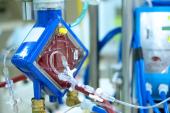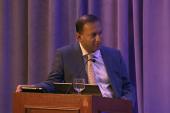Cardiogenic Shock Outcomes Markedly Worse in De Novo HF Patients
When heart failure is de novo, rather than acute-on-chronic HF, shock escalates more quickly and outcomes are worse.

Patients with cardiogenic shock in the setting of heart failure (HF) fare worse if their disease is de novo than if they’ve previously received an HF diagnosis, according to an analysis of the Cardiogenic Shock Working Group (CSWG) registry. These individuals face faster progression to more-severe disease as well as higher rates of in-hospital death and cardiac arrest.
Efforts to delineate the best treatment strategies specific to these “cardiogenic shock phenotypes are urgently needed,” Jaime Hernandez-Montfort, MD (Baylor Scott and White Health, Temple, TX), and colleagues write in a paper published online this week in JACC: Heart Failure.
Navin K. Kapur, MD (Tufts Medical Center, Boston, MA), the study’s senior author, told TCTMD it’s a follow-up to an earlier report from the CSWG showing higher mortality when the etiology of cardiogenic shock is acute decompensated HF as opposed to acute MI. “The main observation we were seeing, both at the bedside and also when we looked at the data, was that the trajectory of these patients is very different,” he noted.
Srihari S. Naidu, MD (Westchester Medical Center, Valhalla, NY), said he’s pleased to see growing interest in understanding cardiogenic shock that occurs in the context of HF. “There is a dearth of data on what happens to these non-AMI cardiogenic patients,” he noted. “Previously, we thought these [cases] were much more benign, because without the ischemic substrate we would think that there’d be less arrhythmia, less potential for spiraling into the later stages of shock. But what we’re finding is that [HF] patients are still a very high-risk cohort.”
Within the subcategory of HF patients, many live in a chronic state of low output and are less vulnerable when acute decompensation occurs, Kapur said. “Their bodies are now accustomed to not having enough blood pressure. They have a different neurohormonal response to that. Their sympathetic system is activated, and that can go on for months or years.”
The main observation we were seeing, both at the bedside and also when we looked at the data, was that the trajectory of these patients is very different. Navin K. Kapur
Naidu agreed that patients with HF before cardiogenic shock “tend to do better, because the chronicity of their disease seems to be able to sustain end-organ function to a longer duration,” such that they make it to heart transplant or implantation of a durable left ventricular assist device (LVAD).
Others, however, come into the hospital without a known history of heart failure and then develop it in relation to myocarditis, valvular heart disease, or arrhythmias, or their existing HF may simply not have been diagnosed.
In many ways, de novo HF patients “act more like the AMI population, where all of a sudden the whole body takes a hit and the end organs are now having lower perfusion so they deteriorate quickly,” said Naidu, adding, “These patients, they need a lot more attention. It does seem like [they] escalate fast and deteriorate more, with less survival.”
CSWG Subsets
The current analysis includes 3,455 cardiogenic-shock patients treated at 17 centers between 2016 and 2021. Among them, 51% had HF-related shock; for 19.8% of this group, the HF was de novo.
Notably, as described in a paper published this summer in the Journal of the American College of Cardiology, the CSWG definition for what constitutes stage B shock is slightly different than the original SCAI SHOCK criteria. In the CSWG analyses, stage B encompasses untreated hypoperfusion and hypotension, whereas SCAI SHOCK places patients with hypoperfusion in stage C, irrespective of hypotension.
This analysis looking at the two phenotypes of HF-related cardiogenic shock “is the first follow-on study” after that paper to now implement that CSWG stage B, Kapur said. “For clinical care, what we’re saying is if you’re at [stage] B, that doesn’t mean you’re beginning shock. It means that you’re already in pretty bad shock,” he explained, adding that early awareness of a stage B patient’s condition can trigger physicians to take steps that prevent them from deteriorating further.
Here, 19.4% of patients were stage B at baseline, while 23.6% were stage C, 34.4% stage D, and 22.7% stage D. Those with de novo HF were more likely than those with acute-on-chronic heart failure to present in the CSWG’s modified SCAI SHOCK stage C or D, to achieve a maximum stage of D, and to more rapidly escalate in terms of cardiogenic-shock severity. They also were more likely to die in the hospital (32% vs 22%) and to experience cardiac arrest, both in-hospital (23.1% vs 11.5%) and out-of-hospital (17.0% vs 7.5%; P < 0.001 for all).
In-hospital cardiac arrest (IHCA) was particularly risky no matter the shock type. Around two-thirds of patients with these in-hospital events died during their stay, at rates of 63% for de novo HF and 65% for acute-on-chronic HF (as compared with 21% and 17%, respectively; P < 0.001 for both). Out-of-hospital cardiac arrest (OHCA) also significantly increased mortality for patients with acute-on-chronic HF (46% vs 21%; P < 0.001) but not for those with de novo HF (36% vs 30%).
The SCAI SHOCK stages should be done on admission and rapidly, not just at 24 hours but on an ongoing basis, and these patients need to be escalated quicker, especially the de novo heart failure patients. Srihari S. Naidu
These data shed light on what drives mortality in cardiac arrest, Kapur pointed out. Unlike with OHCA, where lack of blood flow to the brain is more important, with IHCA “you’re getting pretty much immediate bystander CPR,” so the neurologic aspect is less influential, he said. “With these heart failure patients, they’re already so frail that if they develop in-hospital cardiac arrest it’s very hard to pull them out of that condition. And we think that the mortality is either due to nonsalvageable cardiac status or the therapies that get implemented” in such a dire situation.
Mechanical circulatory support (MCS) was given to 7% of all patients with HF-related cardiogenic shock within the first 24 hours. “That’s abysmal,” said Naidu, and suggests these patients are undertreated due to the misperception that HF-related shock is more benign than acute MI-related shock. Treatment should be tailored toward a given case’s cardiogenic-shock severity, not its substrate or etiology, he added. “The SCAI SHOCK stages should be done on admission and rapidly, not just at 24 hours but on an ongoing basis, and these patients need to be escalated quicker, especially the de novo heart failure patients.”
In total, 45% received MCS—most often intra-aortic balloon pump—during hospitalization. Use was highest among the patients who were discharged on a durable LVAD or underwent heart transplantation.
Kapur said further analyses of CSWG data are on the horizon: looking at the acute MI subgroup, the impact of transfer, and use of pulmonary artery catheters. As the registry continues enrolling patients over the years, it also will be possible to tease out differences related to MCS devices, he added.
Caitlin E. Cox is News Editor of TCTMD and Associate Director, Editorial Content at the Cardiovascular Research Foundation. She produces the…
Read Full BioSources
Hernandez-Montfort J, Kanwar M, Sinha SS, et al. Clinical presentation and in-hospital trajectory of heart failure and cardiogenic shock. J Am Coll Cardiol HF. 2022;Epub ahead of print.
Disclosures
- This work was supported by National Institutes of Health grants to Kapur and institutional grants from Abiomed, Boston Scientific, Abbott Laboratories, Getinge, and LivaNova to Tufts Medical Center.
- Hernandez-Montfort is a consultant for Abiomed and Abbott Laboratories.
- Hernandez-Montfort is a consultant for Abiomed and Abbott Laboratories.
- Naidu reports no relevant conflicts of interest.




Comments